6. March – Unternehmen Fruhlingserwachen begins (lasts 10 days)
13. SS remains in the Margarettestellung for the duration of Op. Fruhlingserwachen. Expecting the German positions at Haromfa to be weaker now, the Soviets attack several times and are thrown back each time. The lull in the fighting allows pioniers to assist units of the 71st Wehrmacht in clearing 5,000 Russian mines. It is likely that this decision was undertaken with the future thoughts of offensive actions in Hungary.
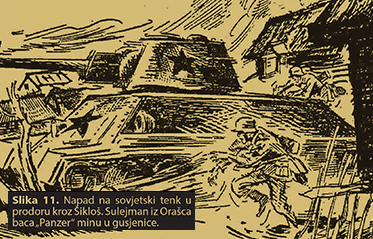
7. March – “heavy fighting lasting the whole day, northeast of Jako.”
8. March – “a mere company stops an enemy in battalion strength south of Haromfa, enemy halted, three tanks disabled”
9. March – “3 POWs taken near Haromfa (estimated 80 enemy dead). Friendly casualties: 19 dead, 62 wounded (!), 5 missing.”
11. March – “enemy counterattack beaten back.”
16-17. March – Kampfgruppe Hanke attacks Heresznye (its last offensive action of the war) Advances 300m before being called to a halt, Russians thrown out of their positions.
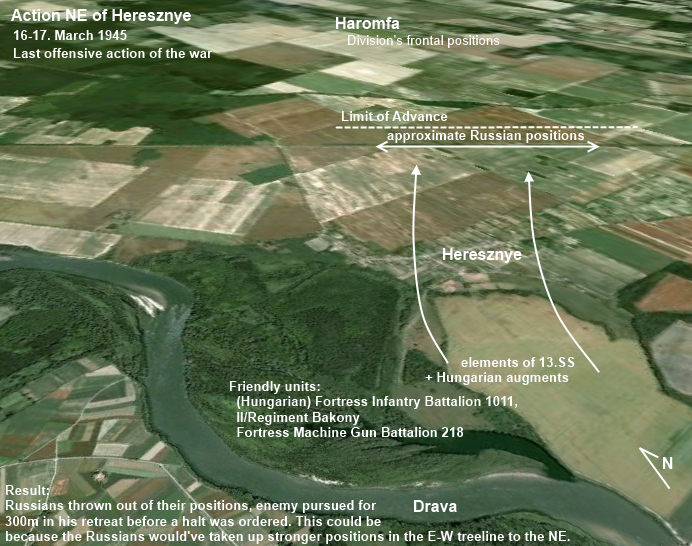
29. March – The 1st Bulgarian and 57th Soviet Armies launch an all out offensive against the 2nd Panzer Army.
“Enemy infantry once again exploited gaps and closed in the distance fast resting in sunken ground close in front of 13 SS positions where only mortars could hit them and the latter ran out of proper propellant charges for such short ranges.”
30. March – I/27 repulses Russians at Csurgo.
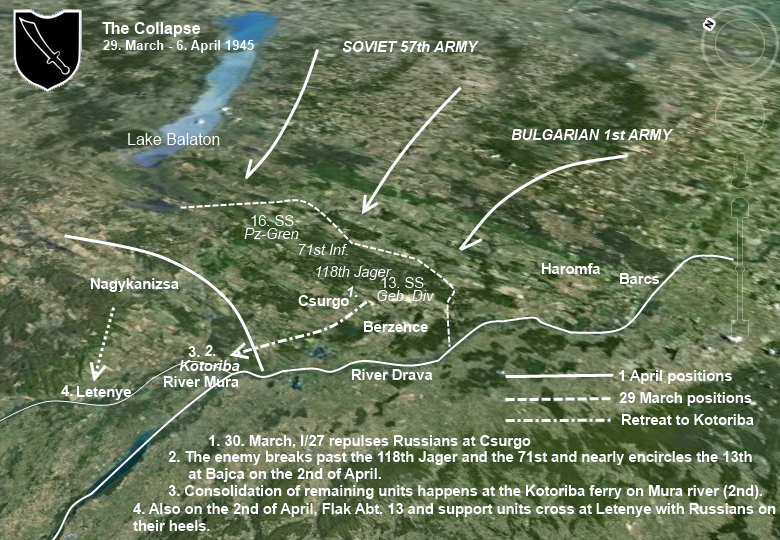
2. April – Soviets strike between the 118th Jager and 71st Inf. Divisions, once against almost encircling the 13th SS Division at Bajca. The retreat to the Mura river begins.
3-5. April – Flak units leave Nagykanizsa and cross at Letnye
Companies from II/27 provide a rearguard, holding the Soviet armor off long enough for the crossing to happen. In the attrition entire companies are dwindled down to platoon strength.
Likewise at Kotoriba and armed only with rifles, elements of the division knock out some of their first tanks in urban combat. Here the division consolidates and forms line Dravovid where it holds out against lead Soviet units for 3 days.
6. April – the battlegroup retreats within the borders of Grossdeutschland. Here they were augmented here by everyone from Hungarian infantry, Volkssturm to Italians.
7. April – I/27 is initially thrown out of its positions but regains them during a counterattack.
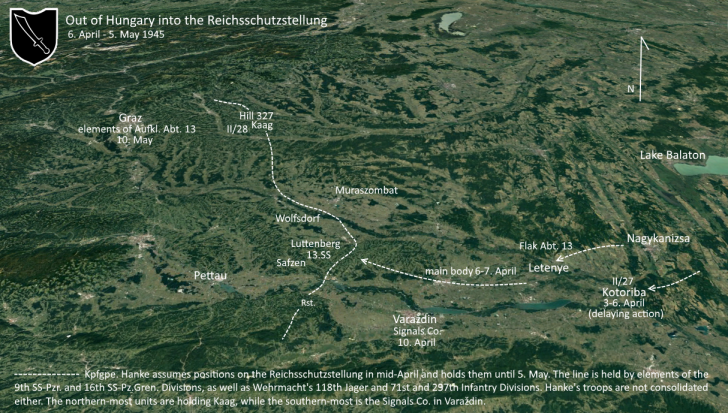
“On 9 April, six of us were ordered to conduct reconnaissance of Russian positions. As were carrying this out, the Russians detected us and opened fire. I was shot in my left knee. We returned to our lines. What rotten luck! The war would be over in less than a month and I am wounded!” -Ibrahim Alimabegovic
Ibrahim’s CO (I/27) offered a similar after-action report for 8. April 1944:
“After a short but intense artillery barrage the enemy came at us. We were quickly thrown out out of our positions. The order from the regimental commander stated specifically that the line was to be held at all costs….so we counter-attacked and regained the lost ground. While firing at the retreating enemy, I was shot through my right arm. As my wound was being attended to we came under enemy mortar fire that injured a number of the men, including our imam.”
Another veteran summed it up this way: “We fought the Russians across most of Hungary and into Austria. The most horrifying experience was being under fire by the Katyushas”
11. April – 8th Co./27th Regt. Repulses a large force of Bulgarians, killing 64, losing 10 KIA.
13. April – Russian forces fail to take Kaag.
14. April: Hill 327 (Regt 28) Slovenian Volkssturm switch sides. High ground remains German after repelling a tank assault. Two days later, Russians are pushed out of the area for the time being.
16 April: 5th Company/Regt 27 takes Hill 295 with the aid of two Hetzers. Division’s artillery thwarts a large Russian attack the next day.
19. April – Regt. 28 fights its last engagement at Kiesmanndorff
19. April – May 5th – Present positions on the Reichschutzstellung held until Capitulation. Relieved by Wehrmacht units.
29. April – Himmler commits suicide
30. April – Hitler commits suicide
5-7. May – A hasty defense taken up on the Ursulastellung.
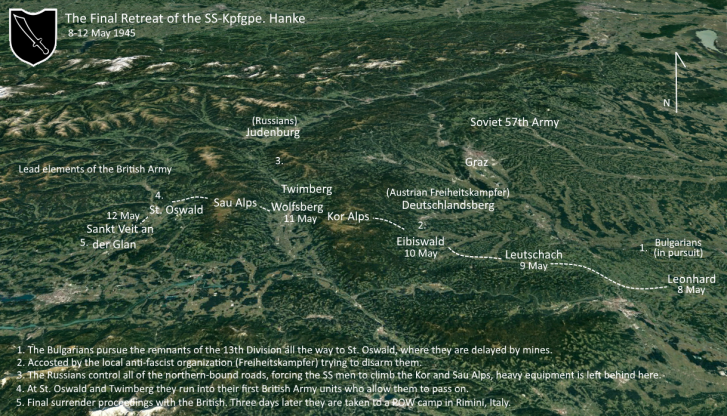
8 May: Through Patzing – Unterochsenau – Skofzen to Hirschendorf.
9 May: Through Ragosnitz – Strahleck – Pössnitzhofen to Kunigund.
10 May: Through Georgenhof – Leutschach – Arnfels – Gründorf to Deutschlandsberg.
11 May: Through the Kor Alps to Twimberg.
8. May – news of capitulation reaches members of the division. Many Bosnians opt to head back southward and face the consequences. 3,000 remain on with the battle group, eventually ending up in a POW camp in N. Italy. Reprisals are rumored to have started as early as 24. April. It is not know how many of these ended up at Bleiburg.
Order of the day: “Do not provoke, but if they attack, destroy them.”
On the night of 7-8. May 1945 the Russians, who were 300m ahead of us began firing off signal rockets. This lasted all night. We didn’t exactly know what to make of this. The regimental command notified us of the capitulation and that we should pull out without alerting them, and that we were to cross a certain demarcation line by a certain hour. I had previously told my wife: I am not going into captivity. If I have no other option I will kill myself. – Franz Zauner
“Near Deutschlandsberg, the troops were accosted by the anti-fascist Oesterreichische Freiheitskämpfer, who demanded that the SS men surrender their weapons. The Handschar troops refused.
Near St. Oswald, the Handschar men saw their first British soldiers. As the Bulgarians were still in pursuit, the Handschar Division attempted to delay them with mines. The Russians had already seized Judenburg, so the SS Division continued its retreat through the Sau Alps. On 12 May, they passed through Lölling and Silberberg and finally reached St. Veit an der Glan.
St Veit an der Glan 12 May the Handschar Division commander, Desiderius Hampel, escorted by his adjutant, Sturmbannführer Karl Wambsganß, conducted formal surrender negotiations with the British army.” – from my correspondance with G. Lepre
“We spent the entire night with the commander of our platoon, Hstf Kinz. We could not sleep that night or over the night few nights. We could not comprehend that the end has come. The next day we arrived in Graz. A low flying Russian plane flew over us but did not fire on us. Then we began over the Alps via narrow mountain paths. The Russians were already in possession of the main roads. We crossed over the Kor and Sau Alps (now Golica and Svinja – Slovenia). There we discarded most of our baggage and most of the vehicles. The motor vehicles that could not make it were pushed off the cliffs. The Russians were right behind us. In the vicinity of Judenberg we came upon the first English tanks. They let us pass and left us with our weapons. Near St. Veit, which is near Klagenfurt, we made camp on a nearby field. From there we had to go to Munich and there be released. We took off our SS badge and rank insignia.”
W. Ebeling Aufkl. Abt .13 May 45
One division member recalled how, on the way back home, he had to first become a partisan simply to make it through their lines. He shed his SS uniform and put on a dead Domobran’s uniform. When he was finally apprehended by the partisans, they immediately inducted him into his ranks. A month went by and one day an officer began interrogating him about his age. When he found out that he was under 18, the partisan officer promptly told him to go home. Little did he know that he was letting an SS veteran go home. He joined (or was conscripted into) the SS at an age of 16 and had fought for the whole of year 1944 before turning 18.
The deserters would often discard the soldbuchs, medals and decorations in fear of retribution, if not betrayal. They would later find difficulty attaining German pensions as a result of this. The authors grandfather was one such individual who was given a German pension despite no Soldbuch.
Accord to. Imamovic, a sizeable group of Bosniaken immigrated and settled in the area around Bradford in England. Which is amusingly enough where the former chetniks were relocated to as well. Stories tell of their mutual hatred well after the war.
Post war – anti Communist Resistance.
Resistance to communist rule took part all over eastern Europe but was mostly small scale and covert. In Croatia and Bosnia it was the “Crusaders” and included both Catholic and Muslim members. They were mostly led by Ustasa officers who had no other option but to resist. Though they remained active until 1950, most were either killed or captured by 1947. Like the Wehrwolf resistence in Germany the damage they caused was negligible.